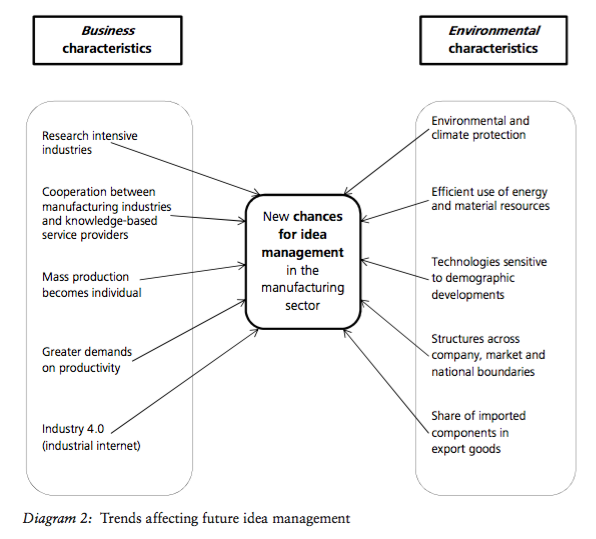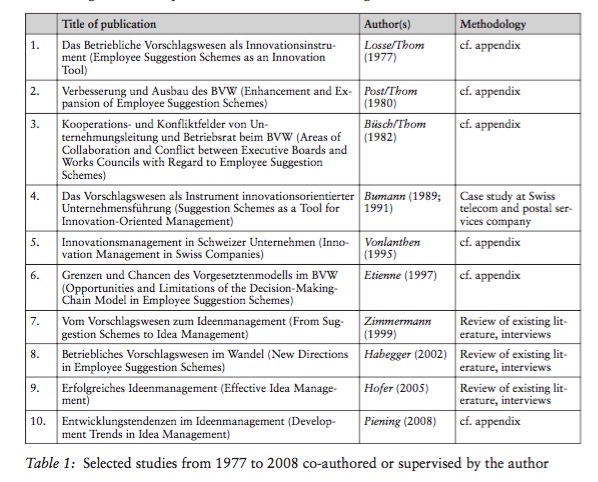Die Ursprünge des Vorschlagswesens können bis auf das Jahr 1750 zurückgeführt werden. Insofern ist das heutige Ideenmanagement eines der nachhaltigsten Managementkonzepte. Es wurde im Laufe der Zeit ständig den veränderten Bedingungen in den wirtschaftlichen, sozialen, technischen und ökologischen Umweltsegmenten angepasst. Die zu beantwortende Kernfrage blieb immer konstant:
„Wie können Beschäftigte motiviert und qualifiziert werden, durch ihre konstruktiven und kreativen Ideen zur kontinuierlichen Verbesserung der betrieblichen Prozesse und Produkte beizutragen?“
Auf der Basis der langjährigen Forschungserfahrung des Verfassers und einer Reihe von klar erkennbaren Zukunftstrends zeigt dieser Beitrag auf, welche Faktoren den Erfolg des Ideenmanagements in der Vergangenheit und Gegenwart begünstigen konnten und welche neuen Chancen sich in der Zukunft eröffnen.
Since its inception in the 18th century, idea management has turned out to be one of the most persistent management concepts ever. While it has constantly adapted to changing economic, social, technological and ecological environments and will be obliged to continue to do so in the future, it has a stable core that consists in the effort to provide answers to the following question: “How to motivate and empower as many employees as possible to contribute constructive and creative ideas so as to continuously improve operational processes and results?” On the basis of the author’s personal history in research and a number of clearly discernible future trends, the present paper outlines some of the crucial features that successful idea management has had and will have in the past, the present and the future.
A journey in research – a personal retrospective and overview
Table 1 lists a selection of studies dealing with this question which were co-authored or supervised by me between 1977 and 2008. The table contains the six most relevant empirical studies, three literature studies (supplemented by expert interviews) aimed at identifying trends, and an intensive case study at a major Swiss enterprise (postal and telecom services provider). An overview of the most important conclusions and a synoptic account of the development of the employee suggestion scheme/idea management concept are available in Thom/Piening 2009.
Idea management in Switzerland: the present
According to the European Innovation Scoreboard (European Commission 2013), Switzerland is the most innovative of all European countries. One of the 25 indicators used by the scoreboard pertains to “introducing marketing and organizational innovations”. These of course are types of innovation which may well be triggered by idea management.
In the following paragraphs, I turn to the current situation in Switzerland as it presents itself in the most comprehensive recent study conducted under my aegis. The results of this study are presented in more detail in Thom/Piening 2009, 171ff.
Asked about the three most important design features of an idea management scheme, the companies replied as follows (items ranked according to order of importance):
1. Quick and transparent evaluation of submitted ideas
An organisational challenge heads the list: what is required is an internal process that minimises the time between the idea’s submission and its evaluation on the basis of lucid criteria. Submitters want to know why their ideas are approved or rejected and whether and how they might be rewarded.
2. Effective advertising to promote submission of ideas
All employees eligible for participation need to be targeted by advertising media, and as many as possible must be convinced to contribute their ideas. To achieve this, innovation managers must understand the mentality of their workforce, choose their advertising channels accordingly and place advertisements in such a way that they find their mark and trigger the desired response of “Yes, I have an idea and I want to come for- ward with it!” In this context, internal communication processes are key.
3. Decision-making-chain model strongly recommended
With the classic employee suggestion scheme, direct superiors were bypassed in that submitters were asked to turn to a specific suggestion scheme administrator. However, idea managers suggest that effectiveness is greater if submitters contact their immediate superiors first. This does not merely amount to an organisational change; rather, it requires a change in corporate culture. Superiors must be receptive to ideas suggested by their subordinates. These, in turn, are encouraged to approach their superior, who has clearly defined competences to decide whether or not a submission should be accepted and implemented. Only ideas that exceed the direct superior’s area of expertise and/or affect other departments are passed on to the idea manager. Such a restriction of the idea manager’s responsibility will help avoid bottlenecks. Handling suggestions for improvement from employees must become part of any superior’s habitual tasks. This will also likely increase participation and acceptance rates. Implementation will be- come smoother, since there is no initially bypassed superior whom one must convince after the fact of the new suggestion’s benefits; thus subtle obstructions in implementation can be avoided.
A number of further important insights from the study under consideration concern the frame of reference (cf. diagram 1) which was first drafted in Thom/Losse (1977) and which has been continuously enlarged and modified in the course of more than thirty years of research.
 Reference frame for idea management
Reference frame for idea management
Trends in the manufacturing sector and their relevance for idea management: the future
Starting from a number of important economic trends in advanced industrial nations (such as Switzerland and Germany), a series of theses and prospects are proposed below regard- ing the impact these trends are likely to have on idea management.
The presentation of the trends is inspired, among other sources, by Bundesministerium für Wirtschaft und Technologie (2010). This study by the German administration develops plausible scenarios for the coming 5 to 15 years (without resort to statistics):
- Countries with research-intensive industries will keep their strong competitive position
- Environmental and climate protection are gaining in importance
- Efficient use of energy and material resources is called for
- Technologies sensitive to demographic developments have enormous potential for growth
- Mass production becomes individual
- More complex structures will arise across company, market and national boundaries
- Cooperation between the manufacturing industry and knowledge-based service providers will create competitive advantages
- The share of imported components in export goods from the German-speaking countries is on the rise
- Greater demands on productivity
- Industry 4.0
 Trends affecting future idea management
Trends affecting future idea management
Conclusions
Although its mutations have been substantial over time, idea management is in fact one of the most persistent management concepts ever, having been passed down through generations of managers and management theorists since its inception in Venice and Sweden in the middle of the 18th century (cf. the historical overview in Thom/Piening 2009, 1-12). In the German-speaking countries, idea management has been implemented mostly in the manufacturing sector ever since its introduction in Germany by Alfred Krupp in 1872 (for other regions, cf. van Dijk/van den Ende 2002; Sergeeva 2014).
Regarding its future, the conclusions to be drawn from the trends discussed in section 3 and 4 are obvious: as it has consistently been doing throughout its history, idea management must continue to adapt to changing economic, social, technological and ecological environments. Its core, however, remains the same: it must go on dealing with the question of “how to motivate and empower as many employees as possible to contribute constructive and creative ideas so as to continuously improve operational processes and results”. If the necessary adaptations are administered with care, it will continue to do so successfully.
Download and read the full article (pdf): Idea Management in Switzerland and Germany: Past, Present and Future
Author:
Prof. Dr. Norbert Thom
Universität Bern
Institut für Organisation und Personal (IOP)
www.iop.unibe.ch
Reto Steiner und Adrian Ritz geben Festschrift für Prof. Dr. Nobert Thom heraus
Unter dem Titel “Personal führen und Organisation gestalten” ist eine Festschrift für Prof. Dr. Prof. h.c. Dr. h.c. mult. Norbert Thom erschienen. Diese Festschrift umfasst die wichtigsten Publikationen von Professor Thom zusammen und ist im Haupt Verlag, Bern, erschienen. Organisationen erfolgreich…
Die Entwicklung des Betrieblichen Vorschlagswesens BVW lässt sich über mehr als hundert Jahre zurück verfolgen. Seit seiner Entstehung um 1880 haben sich die Ziele, die Unternehmen mit dieser Einrichtung verfolgen, verlagert. Wurde das BVW anfangs vor allem als Rationalisierungsinstrument…
Prof. Dr. Norbert Thom und Dr. Michele Etienne: Effizientes Innovationsmanagement
Grundvoraussetzungen in der Unternehmensführung und im Personalmanagement Dass Innovationen für die Erhaltung der Wettbewerbsfähigkeit und damit auch für das langfristige Überleben des Unternehmens unverzichtbar sind, wird heute allgemein anerkannt. Es stellt sich somit nicht mehr die Frage, ob innoviert werden…
Prof. Norbert Thom: Institut für Organisation und Personal IOP, Bern
Das Institut für Organisation und Personal (IOP) ist ein wissenschaftlich unabhängiges Institut der Universität Bern, das sowohl national als auch international ausgerichtet ist. Schwerpunkte bilden die Fachgebiete Organisation und Personal als wichtige Komponenten der Unternehmensführung. Das IOP fördert das europäische…
Seit 110 Jahren gibt es in der Schweiz ein Konzept, das darauf ausgerichtet ist, kreative Ideen von Mitarbeitenden zu erhalten, zu bewerten und umzusetzen. Die Bally Schuhfabriken AG in Schönenwerd war der schweizerische Pionier. Im Ausland gab es bereits Vorreiter…


